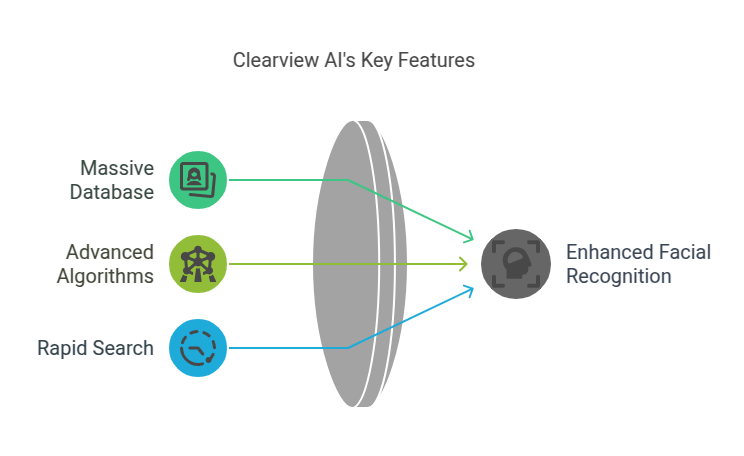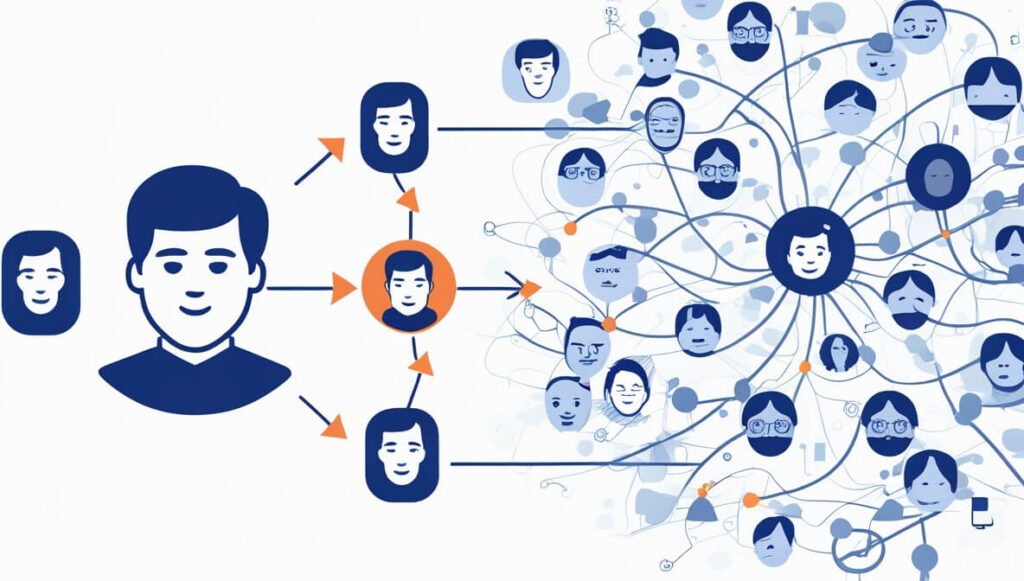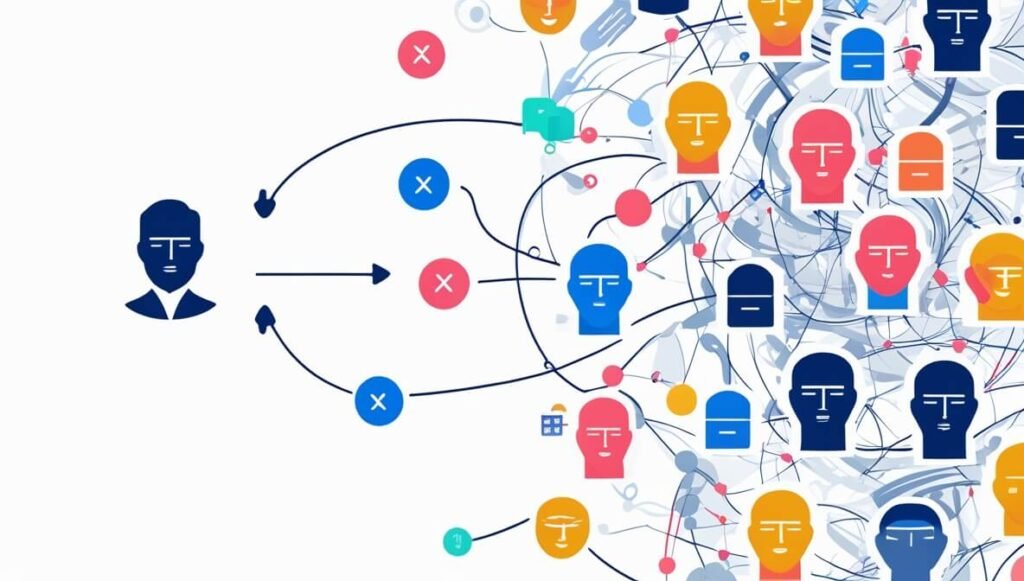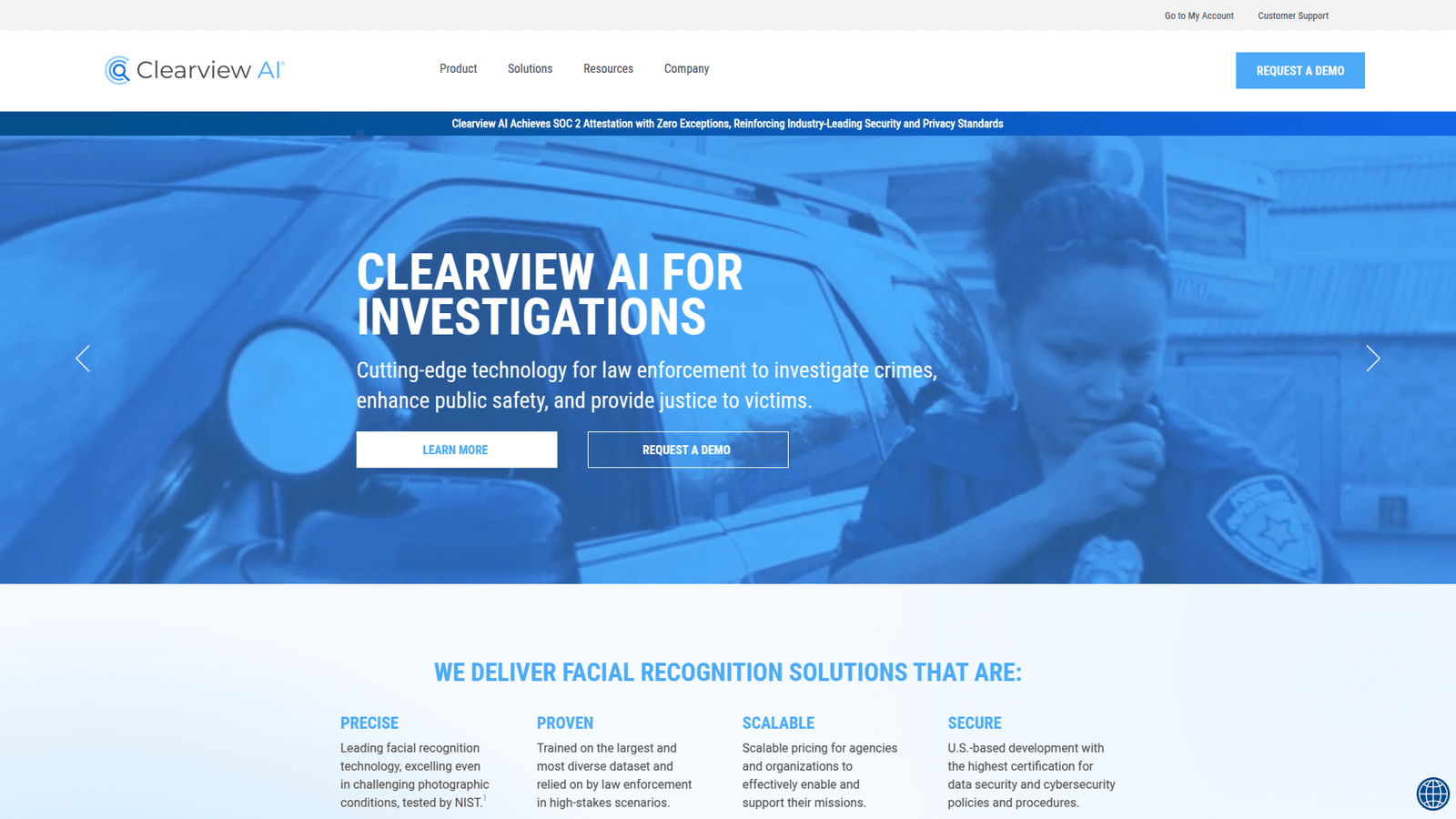Clearview AI transforms Facial Recognition and Verification for Security and Moderation pros. Boost efficiency, save time, get results. See how it works now!
Why Clearview AI Is a Smart Choice for Facial Recognition and Verification
Alright, let’s talk about making things happen.
You’re in the Security and Moderation space.
Things are moving fast.
AI is everywhere, right?
But it’s not just hype anymore.
It’s a tool.
A tool that can either crush you or make you unstoppable.
Especially when it comes to Facial Recognition and Verification.
This stuff is critical.
Lives, safety, reputation – it’s all on the line.
And doing it manually?
Good luck keeping up.
That’s where Clearview AI pops in.
You might have heard the name.
Maybe you’ve seen the headlines.
But peel back the layers.
This isn’t just another tech gadget.
It’s built for solving real problems.
Hard problems.
The kind you face every single day.
If you’re bogged down, feeling overwhelmed, or just know there has to be a better way…
You need to pay attention.
We’re going to break down what Clearview AI actually does.
How it fits into your world.
And why, for many, it’s not just a good idea – it’s essential.
No fluff.
Just the facts.
Let’s get after it.
Table of Contents
- What is Clearview AI?
- Key Features of Clearview AI for Facial Recognition and Verification
- Benefits of Using Clearview AI for Security and Moderation
- Pricing & Plans
- Hands-On Experience / Use Cases
- Who Should Use Clearview AI?
- How to Make Money Using Clearview AI
- Limitations and Considerations
- Final Thoughts
- Frequently Asked Questions
What is Clearview AI?
Okay, let’s cut to the chase.
Clearview AI is a facial recognition technology company.
Sounds simple, right?
But it’s not just about pointing a camera at someone.
Their core thing is building a massive database of facial images.
These images are collected from publicly available web pages on the internet.
Then, they use their AI algorithms.
These algorithms can match faces.
Match a face in a query image to faces in their database.
The target users are specific.
We’re talking law enforcement.
Government agencies.
Security professionals.
Folks who need to identify people.
Fast.
It’s not a tool for the general public.
You can’t just download an app and start scanning random people.
It’s designed for serious work.
Work that involves public safety.
Work that involves finding suspects.
Work that involves Security and Moderation on a large scale.
Think cold cases.
Think identifying witnesses.
Think verifying identities in high-stakes situations.
Their tech focuses on taking an unknown face.
Comparing it against billions of faces.
And returning potential matches.
Along with links to where those images appeared publicly online.
It gives investigators a lead.
A starting point they didn’t have before.
It’s a powerful search engine.
But for faces.
That’s the essence of Clearview AI.
A tool built for identifying individuals using Facial Recognition and Verification technology.
Key Features of Clearview AI for Facial Recognition and Verification

So, what does this thing actually do under the hood?
When you’re talking about Facial Recognition and Verification in a serious setting, you need specific capabilities.
Clearview AI brings several key features to the table.
- Massive Database: This is arguably their biggest play.
Clearview AI boasts a database containing billions of facial images.
These are collected from the public internet.
News articles, public social media profiles, websites.
It’s a huge pool.
Why does this matter?
The bigger the database, the higher the chance of finding a match.
Especially for people who aren’t already in traditional databases.
Like mugshots or ID photos.
It gives investigators a much wider net to cast.
This scale is a game-changer for cold cases or identifying unknown persons.
- Advanced Matching Algorithms: It’s not just about having a lot of pictures.
You need the tech to compare them accurately.
Clearview AI uses sophisticated AI algorithms for facial recognition.
These algorithms can handle variations.
Different angles.
Poor lighting.
Obstructions like hats or glasses.
Changes in appearance over time.
They generate a unique facial template or ‘faceprint’ from a query image.
Then, they compare that template against the faceprints in their massive database.
This tech is designed for **accuracy** and speed.
Crucial when you’re working under pressure.
- Rapid Search and Results: Time is often critical in Security and Moderation scenarios.
Waiting hours or days for a potential identification isn’t always an option.
Clearview AI is built for speed.
Users can upload a photo.
The system processes it quickly.
It runs the comparison against billions of faces.
And it returns potential matches in moments.
These results include the confidence score of the match.
And crucially, links to the original public web pages where the matching images were found.
This isn’t just an identification.
It’s a lead.
It provides context.
It points investigators to publicly available information related to the person.
This speeds up the investigative process dramatically.
Reduces the manual effort needed to follow leads.
And helps teams make faster, more informed decisions.
These aren’t just abstract features.
They translate directly into capability.
Capability needed for effective Facial Recognition and Verification in tough situations.
It’s about turning an unknown face into a potential identity and actionable intelligence.
Benefits of Using Clearview AI for Security and Moderation
Okay, let’s talk about why someone would actually use this thing.
Especially in high-stakes fields like Security and Moderation.
What’s the payoff?
It boils down to a few core benefits.
Things that make a real difference on the ground.
First, **speed and efficiency**.
Identifying a person manually from just a photo can be incredibly slow.
It might involve sifting through databases.
Checking public records.
Following vague leads.
Clearview AI automates a huge part of this.
Upload the image, get potential matches and links in minutes.
This frees up valuable time for investigators.
They can spend less time searching and more time investigating.
Second, **access to a wider pool of information**.
Traditional databases are limited.
They contain people who have been arrested, fingerprinted, or issued specific IDs.
What about everyone else?
The witnesses?
The potential suspects not yet in the system?
Clearview AI’s public web data fills this gap.
It provides potential identification for individuals who wouldn’t be found otherwise.
This is huge for solving cold cases or identifying individuals involved in incidents where no prior record exists.
Third, **improved accuracy in initial identification**.
While no system is perfect, advanced AI algorithms are highly effective at comparing facial features.
They can detect subtle similarities humans might miss.
Or filter out false positives more effectively than manual methods.
The system provides a confidence score, helping users assess the likelihood of a match.
And the linked source images allow for visual verification.
This doesn’t replace human judgment.
But it provides a strong, data-driven starting point.
Fourth, **helping solve difficult cases**.
Think about cases where the only lead is a blurry surveillance image.
Or a photo of an unknown person involved in an incident.
Without a tool like Clearview AI, these leads might go nowhere.
The ability to search a vast database from just an image can provide that crucial first step.
It helps identify suspects, locate missing persons, or identify victims.
Finally, **enhanced verification processes**.
Beyond just identification, the technology can be used for verification.
Verifying the identity of someone against a known image.
In high-security settings, confirming someone is who they claim to be is vital.
Clearview AI’s accuracy and speed contribute to more robust verification protocols.
These benefits add up.
They mean faster investigations.
More leads pursued.
And ultimately, a better ability to maintain safety and security.
That’s the real value proposition.
Pricing & Plans

Alright, let’s talk brass tacks.
How do you get your hands on Clearview AI?
And what does it cost?
First off, this isn’t a consumer-level product.
There’s no free trial you can sign up for online.
No monthly subscription button for individuals.
Clearview AI works with specific clients.
Primarily law enforcement and government agencies.
Their sales model is geared towards organisational contracts.
Pricing isn’t publicly listed on their website in simple tiers like “Basic,” “Pro,” or “Enterprise.”
It’s typically based on the specific needs of the agency.
Things like the number of users.
The volume of searches expected.
Integration requirements with existing systems.
The duration of the contract.
So, if you’re a police department or a federal agency interested, you contact their sales team.
They’ll work with you to figure out a custom package.
And that package will have a price tag tailored to your operation.
Compared to what?
Compared to building a similar system yourself?
That would be astronomically expensive.
Developing the AI, building and maintaining a database of billions of images, ensuring compliance.
It’s a massive undertaking.
Compared to manual investigation methods?
You have to factor in the cost of personnel time.
The hours spent sifting through records.
The leads that go nowhere because identification is impossible.
The potential cost of unsolved cases.
From that perspective, the cost of Clearview AI is positioned as an investment.
An investment in efficiency, capability, and results.
While exact figures aren’t public, reports suggest contracts can range from tens of thousands to hundreds of thousands of dollars annually, depending on the agency’s size and usage.
Again, this isn’t Netflix.
It’s a specialised tool for a specialised market.
The cost reflects the sophistication of the technology and the value it provides to Security and Moderation professionals facing complex identification challenges.
Hands-On Experience / Use Cases
Alright, let’s get concrete.
What does using Clearview AI actually look like?
And where is it being used?
The user interface is designed for investigators.
It’s typically a web-based portal.
An authorised user logs in.
They have a photo of an unknown person.
Maybe it’s from surveillance footage.
Maybe it’s from a social media post related to a crime.
Maybe it’s a picture of a missing person.
They upload that image to the system.
Clearview AI’s algorithms go to work.
They scan their database of billions of images.
In moments, the system returns potential matches.
These aren’t just faces.
The results page shows the uploaded image alongside potential matches from the database.
For each match, it shows a confidence score.
Crucially, it provides links to the original web pages where the matching images were found.
This is key.
It allows the investigator to click through.
See the context of the image.
Gather more information about the person.
Confirm if it’s likely the same individual.
It doesn’t just give a name.
It gives a lead.
A starting point for further investigation using traditional police methods.
Real-world use cases are focused entirely on law enforcement and government Security and Moderation.
**Case Study Example (Simulated):**
Imagine a police department is investigating a robbery.
Surveillance cameras captured a clear image of the suspect’s face.
However, the suspect isn’t known to local police.
No matches in their internal mugshot database.
Instead of hitting a dead end, an investigator uploads the surveillance image to Clearview AI.
Within minutes, the system returns several potential matches.
One match has a high confidence score.
The link associated with that match leads to a publicly viewable social media profile.
The investigator visits the profile (which was public information).
They see more photos of the person, confirming the likeness.
They find a name, location, and potentially associates.
This information provides the first solid lead in the case.
Detectives can then follow up using standard investigative procedures.
Interviewing neighbours, checking known addresses, building a case.
Without Clearview AI, that surveillance image might have been useless.
Other use cases include:
Identifying victims or perpetrators of child sexual abuse material by matching faces in illicit imagery to public photos.
Identifying individuals involved in protests or civil unrest captured in public photos or videos.
Identifying potential witnesses to a crime captured in the background of photos.
Locating missing persons by comparing recent photos to the database.
Verifying the identity of individuals during investigations or at secure checkpoints (though this is less common than investigative search).
The interface is designed to be straightforward for someone trained in investigations, focusing on uploading, searching, and reviewing results and source information for Facial Recognition and Verification.
Who Should Use Clearview AI?

Okay, who is this tool actually for?
Let’s be super clear here.
Clearview AI is not for everyone.
It’s not for individuals.
It’s not for private companies doing general background checks.
It’s not for marketing.
It’s not for verifying customers at your corner shop.
The intended and primary users are specific organisations within the public sector.
**Law Enforcement Agencies:** This is the biggest user group.
Police departments (local, regional, national).
Sheriff’s offices.
Investigative units.
They use it for identifying suspects, victims, or witnesses in criminal investigations.
Solving cold cases where traditional leads have dried up.
Identifying individuals from surveillance footage or crime scene photos.
**Government Agencies:** Various governmental bodies involved in Security and Moderation may use it.
Federal investigative agencies.
Agencies responsible for national security.
Groups working on human trafficking or child exploitation cases.
Their needs often involve identifying individuals across a wide geographic area or in cases crossing jurisdictions.
**Public Safety Professionals:** While overlapping with law enforcement, this category includes others focused on maintaining public order and safety.
Units focused on locating missing persons.
Teams responding to major incidents where identification is needed quickly.
The key requirement for a Clearview AI user?
They need to have a legitimate law enforcement or public safety need.
Access is granted based on strict verification of the agency’s credentials and intended use.
The company has faced legal challenges and scrutiny regarding its data collection and usage.
As a result, they have increasingly restricted access to only governmental Security and Moderation entities for specific, approved purposes.
So, if you’re not working for one of these types of organisations with a genuine need for Facial Recognition and Verification in investigations or public safety…
Clearview AI is not the tool for you.
It’s built for a very specific, demanding audience with critical identification requirements.
How to Make Money Using Clearview AI
Okay, this section needs a bit of a twist compared to most AI tools.
You can’t just “use Clearview AI” as an individual or typical business to offer services and make money.
Remember, access is limited to verified law enforcement and government agencies.
So, you can’t sign up, run searches for clients, and charge a fee.
That model simply doesn’t exist for Clearview AI.
However, if you *are* part of an authorized agency using Clearview AI, you can think about the *value* it brings.
That value translates into savings and effectiveness for your organisation.
And effectiveness often has a monetary equivalent in the public sector – though not direct personal profit.
- Service 1: Providing Faster Investigative Results:
If your unit or agency is using Clearview AI, you are providing a service to the public.
You’re solving crimes faster.
Locating missing persons quicker.
Taking dangerous individuals off the streets sooner.
This isn’t making money in the traditional sense.
But it’s providing immense value.
It reduces the cost associated with prolonged investigations.
It prevents future crimes by apprehending suspects earlier.
The “money saved” or “value generated” is in increased public safety and more efficient use of taxpayer funds.
- Service 2: Augmenting Existing Investigative Capabilities:
Clearview AI doesn’t replace detectives.
It enhances them.
Agencies using the tool can tackle cases they previously couldn’t.
They can identify leads from seemingly useless evidence like a poor-quality image.
This leads to higher case closure rates.
Again, this is about operational effectiveness.
A police department that closes more cases justifies its budget.
Secures funding for more resources.
While not personal profit, it’s financial health and growth for the organisation.
- Service 3: Specialised Unit Effectiveness:
Think about specialised units focusing on things like human trafficking or online child exploitation.
Identifying victims and perpetrators from online imagery is critical.
Clearview AI’s ability to match faces from these challenging images to public profiles is a powerful capability.
An agency with this tool is better equipped to handle these complex, sensitive cases.
This translates into successful operations, which reinforces the unit’s value and secures its necessary funding.
Success in these areas often attracts grants and other financial support for the agency.
So, you don’t “make money” with Clearview AI like a freelancer using AI writing tools.
The financial gain is organisational.
It’s about **efficiency, capability, and achieving critical public safety outcomes** that justify budget allocation and demonstrate value to the community and funding bodies.
It’s leveraging advanced Facial Recognition and Verification technology to be more effective in your core public safety mission.
Limitations and Considerations
Okay, nothing is a magic bullet.
And Clearview AI is no different.
While powerful, it has limitations.
And using it comes with significant considerations.
First, **accuracy isn’t perfect**.
AI facial recognition systems, including Clearview’s, can produce false positives.
They might return a match that isn’t the right person.
Factors like image quality, age differences, and changes in appearance can affect results.
Clearview provides a confidence score, but this is a statistical measure, not a guarantee.
Users must understand this and use the results as investigative leads, not definitive proof of identity.
Manual verification and further investigation are always necessary.
Second, **ethical and privacy concerns**.
This is the big one.
Clearview AI’s practice of scraping billions of images from the public internet without individuals’ explicit consent has drawn massive criticism and legal challenges globally.
Concerns centre around mass surveillance, potential for misuse, and individuals’ right to privacy.
Regulators in several countries (including parts of Europe, Canada, and Australia) have ruled that Clearview AI’s activities violated privacy laws.
In the UK, the Information Commissioner’s Office (ICO) fined Clearview AI for breaches of UK data protection laws.
Agencies considering or using Clearview AI must navigate complex legal and ethical landscapes.
They need clear policies on how results are used, stored, and validated.
They must ensure usage complies with all relevant laws and regulations in their jurisdiction.
Third, **bias in AI algorithms**.
Studies have shown that facial recognition systems can exhibit bias.
Often performing less accurately on individuals of certain racial or ethnic groups, women, and older individuals.
This can lead to disproportionate false positives or negatives for these groups.
Users of Clearview AI must be aware of this potential bias.
They need to factor it into their assessment of match results.
Relying solely on the AI’s output without considering potential biases could lead to unfair or incorrect outcomes.
Fourth, **data security and access**.
The system stores sensitive information – images and potential identities.
Ensuring the security of this data is paramount.
Access needs to be strictly controlled and audited.
Any data breach or unauthorised access could have severe consequences.
Finally, **public trust**.
The controversial nature of Clearview AI’s data collection affects public perception.
Law enforcement agencies using the tool may face scrutiny and reduced public trust.
Openness and clear communication about *how* the tool is used (and isn’t used) are crucial.
It’s not about surveillance; it’s about investigative leads from publicly available data.
These limitations and considerations are significant.
Using Clearview AI effectively and responsibly requires more than just logging in and searching.
It demands careful policy, training, legal review, and a commitment to ethical use of Facial Recognition and Verification technology.
Final Thoughts
So, where do we land on Clearview AI?
Look, in the world of Security and Moderation, especially when it comes to Facial Recognition and Verification, you need tools that work.
Tools that save time.
Tools that give you leads you wouldn’t otherwise have.
Clearview AI, by all accounts from its users in law enforcement, does that.
Its massive database and fast search capabilities are powerful.
They can crack cases.
They can help find missing kids.
They can identify individuals involved in serious crimes.
That’s the upside. The real-world impact on public safety can be significant.
But we can’t ignore the other side.
The privacy concerns are legitimate.
The legal battles are ongoing.
The ethical questions about scraping public data are serious.
Any agency using this tool needs to be eyes wide open about these issues.
They need robust policies.
Strict oversight.
Commitment to using it *only* for approved, necessary purposes.
Not for general surveillance.
Not for casual checks.
Is it the right tool for every agency?
Maybe not.
Does it require careful consideration and handling?
Absolutely.
But for agencies facing difficult identification challenges, where other leads have run dry, Clearview AI offers a capability that is hard to find elsewhere.
It’s a tool built for a specific, demanding job.
If your organisation fits the profile and you have the necessary legal and ethical frameworks in place, it’s a tool worth evaluating for its potential to enhance your investigative work and improve public safety outcomes.
It’s not just AI; it’s a powerful search engine for faces, and in critical situations, that can make all the difference.
The world of AI in security is moving fast.
Staying ahead means understanding the tools available, including controversial ones like Clearview AI.
Consider the needs, the capabilities, and the responsibilities.
Then make your call.
Visit the official Clearview AI website
Frequently Asked Questions
1. What is Clearview AI used for?
Clearview AI is primarily used by law enforcement and government agencies.
Its main purpose is Facial Recognition and Verification to identify individuals.
This helps in criminal investigations, finding missing persons, and other public safety scenarios.
It matches faces from photos against a large database of images collected from the public internet.
2. Is Clearview AI free?
No, Clearview AI is not free.
It operates on a contract basis with authorised agencies.
Pricing is customised based on the agency’s size and usage requirements.
It is not available for individual or general public use.
3. How does Clearview AI compare to other AI tools?
Clearview AI is distinct due to its massive database of publicly scraped images.
Other AI tools might focus on content generation, data analysis, or facial recognition within closed systems (like phone unlocking).
Clearview’s focus is specifically on searching a vast external database for investigative leads in Security and Moderation context.
4. Can beginners use Clearview AI?
The interface itself is designed to be user-friendly for trained investigators.
However, effective and responsible use requires understanding its capabilities and limitations.
Users need training not just on the software, but on the proper procedures and legal guidelines for using facial recognition data.
It’s not a tool for casual use.
5. Does the content created by Clearview AI meet quality and optimization standards?
Clearview AI doesn’t “create content” like text or images in the generative sense.
It provides search results based on facial matching.
The “quality” relates to the accuracy of the match and the relevance of the linked source images.
These results are used as leads, which investigators then build upon through standard procedures, which would need to meet their own quality and optimization standards for case building.
6. Can I make money with Clearview AI?
As an individual or typical business, no, you cannot directly make money by using Clearview AI.
Access is limited to verified law enforcement and government agencies for specific public safety purposes.
The value it provides is to these organisations, increasing their efficiency and effectiveness in investigations, leading to better public safety outcomes.
This efficiency can save costs for the agency and help secure funding, but it’s not a personal monetization tool.






